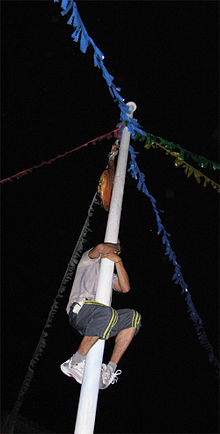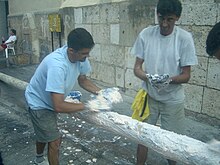This is an old revision of this page, as edited by 190.162.218.163 (talk) at 15:56, 4 April 2021 (→Other regions). The present address (URL) is a permanent link to this revision, which may differ significantly from the current revision.
Revision as of 15:56, 4 April 2021 by 190.162.218.163 (talk) (→Other regions)(diff) ← Previous revision | Latest revision (diff) | Newer revision → (diff)For the Yes Minister episode, see The Greasy Pole. For the Francisco Goya painting, see La cucaña. Not to be confused with Maypole.

Greasy pole, grease pole, or greased pole refers to a tall pole that has been made slippery with grease or other lubricants and thus difficult to grip. More specifically, it is the name of several events that involve staying on, climbing up, walking over or otherwise traversing such a pole. This kind of event exists in several variations around the world. It is also used as a metaphor for the difficulty in achieving the top of one's career.
Canada
As part of Queen's Engineering Frosh Week, the incoming first-year engineering students must, with the help of the upper-year engineering students, climb to the top of a grease pole and remove a tam which is nailed to the pole's top. The Queen's Grease Pole is a metal football goalpost stolen by Queen's engineering students in 1955 from University of Toronto's Varsity Stadium. Currently, the pole is covered in lanolin and placed in the centre of a pit of muddy water referred to as the "Grease Pit", but from the first climbing of the pole in 1956 to 1988 the pole was covered in axle grease and it was only sometime between 1957 and 1967 that the pit was added to the event. There have been various other changes to the rules of the event since its inception, including the banning of the throwing of projectiles at the frosh attempting to climb the pole by upper years, removing unsanitary contents from the pit and allowing women to participate.
The Queen's Grease pole has been the subject of several heists, including in 2000 and 2015 by students from the University of Toronto.
The Bear River Cherry Carnival in Bear River, Nova Scotia offers $100 every year to the first person to walk out their greased pole and grab a Canada flag nailed to the end of the pole. The greased pole is held at a different time every year as they have to schedule it for high tide so there will be water below the pole for competitors to fall into. After the first round, competitors have to make it over the second red ribbon to continue on. Competitors must fall "clean". That is, competitors who grab the pole when falling are immediately disqualified.
Malta

The city of St. Julian's holds a yearly il-ġostra, the greasy pole game. Dating back to the Middle Ages, ġostra, which is derived from the Neopolitan cuccagna, is played in late-August during the Feast of St. Julian. For the greasy pole game, a 20-metre (65 ft) wooden beam is attached to a pier (it has been attached to boats in the past) at an angle and extended over the sea. Flags are attached to the pole, which is then greased. The aim of the game is to run to the end of the pole and grab a flag.
United Kingdom
In the United Kingdom, contests to climb a greasy pole were held at numerous fairs including the Crab Fair in Egremont, Cumbria, where the contest continues to this day, alongside the annual Gurning World Championships. The prize for climbing the 30-foot-long (9 m) pole was originally a hat but from 1852 became a side of mutton, which if there are no winners is cut up and distributed to the poor. In 2004, the greasy pole was discontinued as an event at Egremont Crab Fair, due to high insurance cover costs should a participant fall from the pole. As of 19 January 2008 Egremont is home to a new greasy pole. A 30-foot-long (9 m) sculpture by Turner Prize winning artist Jeremy Deller and collaborator Alan Kane. This is the team's first piece of public art and marks the re-introduction of the Greasy Pole as a crab fair event.
A slight variation is provided at the annual Seaview Regatta on the Isle of Wight. Here the greasy pole is horizontal over the sea and competitors walk along it; the one who walks the furthest before falling into the sea is the winner.
Blakeney in North Norfolk also has a horizontal pole over water that is erected each year for the Blakeney regatta. The event dates back to 1873 and the prize for winning in the early days was a hog. The object is to reach the end by walking along the heavily greased pole, although in recent years sliding has become the preferred method. Blakeney regatta also includes sailing, swimming, and tug of war across the creek.
United States
Gloucester, Massachusetts

The Greasy Pole Contest takes place every year during St. Peter's Fiesta in Gloucester, Massachusetts. During this time, many young men try their luck at walking down a greased, wooden pole in the middle of Gloucester Harbor. The goal is to be the first person to grab the Italian flag at the end of the pole.
New York City
By legend, on 25 November 1783, Evacuation Day, John Van Arsdale climbed up a flagpole deliberately greased by the British as they left New York City, in order to remove the Union Jack and replace it with the Stars and Stripes. An annual flag-raising on the holiday commemorated the event for many years.
Annapolis, Maryland - United States Naval Academy
While not technically a "pole", each year, U.S. Naval Academy freshman (plebes) climb a greased Herdon Monument to represent formal completion of their first of four years. At the top of the greased monument, upper-classmen place the famous plebe "dixie cup" sailors hat, a blue-rimmed version of the classic white sailors hat. Unlike the other greasy pole competitions that have individuals competing against each other, the Herndon climb is a team event where the plebe class works together to hoist one of their members to the top to replace the "dixie cup" plebe hat with the standard midshipmen hat, signalling the end of their journey as plebes. Each year, the latest plebe class races to complete the challenge as fast as possible, with times compared against previous classes. By tradition, the class member who successfully switches out the hat will become the first admiral from that class.

The ceremony also marks the beginning of Commencement Week.
Other regions

Southern Europe - In Spain, the game of climbing the pole is known as a cucaña. In Italy it is called albero della cuccagna.
Netherlands - In the Netherlands it is called sprietlopen.
South America - This is a traditional competition in Chile, where it's known as "Palo Ensebado", people have to climb a pole which has been lubricated with pig or whale fat (depends of the region) and reach a bag of money or assorted goods. This variant of the game is typically done on the Dieciocho's celebration.
Eastern Europe - The game used to be part of rural fairs in some regions of the Russian Empire. The prize at the top of the pole was typically a pair of leather boots.
South East Asia - The game has been introduced into other countries by European colonists. In Indonesia, the game is thought to have been introduced by the Dutch and is called Panjat Pinang, where young men climb up a greased pole to collect prizes. In the Philippines, the traditional Philippine fiesta game of Palo-sebo is derived from the Spanish cucaña.
Zogam - In Chin State, Burma, Mizoram, Manipur of India and Chittagong Hill Tract of Bangladesh, the game of climbing the pole is known as a Sukpum thaltawh and is played during the Zomi feast. It is one of the indigenous games of Zomi.
Metaphor
The climbing of a greasy pole is also used as a metaphor for the difficulty in reaching the top of one's career. This metaphor was used in a well-known quote in Britain by Benjamin Disraeli after becoming the Prime Minister in 1868, "I have climbed to the top of the greasy pole."
See also
References
- "Greasy History". Engsoc.queensu.ca. 8 October 1955. Archived from the original on 28 January 2011. Retrieved 11 September 2010. Alt URL
- "Detailed Events". Engsoc.queensu.ca. 21 September 1976. Archived from the original on 30 January 2011. Retrieved 11 September 2010. Alt URL
- "Queen's Grease Pole". Skulepedia.
- Riley, Jonathan. "David Isles takes fourth flag at Cherry Carnival greased pole". Digby County Courier. Transcontinental Media. Retrieved 15 July 2013.
- Badger, George Percy (1838). Description of Malta and Gozo. M. Weiss. p. 106—107.
- Ltd, Allied Newspapers. "A greasy pole and gunfire mark St Julian's feast". Times of Malta. Retrieved 18 June 2018.
- Rebecca Younger (26 August 2013). "Runners attempt to climb 65ft greasy pole during bizarre Maltese religious festival tradition". The Mirror.
- Baker, Billy (2 July 2017). "GREASE and GLORY". The Boston Globe. Retrieved 3 July 2017.
- Riker, James (1883). "Evacuation Day", 1783: Its Many Stirring Events: with Recollections of Capt. John Van Arsdale, of the Veteran Corps of Artillery, by Whose Efforts on that Day the Enemy Were Circumvented, and the American Flag Successfully Raised on the Battery. author.
- "NK Sprietlopen". RTV Rijnmond. 8 August 2010. Retrieved 3 March 2013.
- "Panjat Pinang – A Slippery Tradition of Indonesia". 3 September 2015.
- ^ Ortony, Andrew (26 November 1993). Metaphor and Thought. Cambridge University Press. ISBN 9780521405614.
- Rigby, Rhymer (24 April 2015). "Climbing the greasy pole: how to get to the top in your career". The Daily Telegraph. ISSN 0307-1235. Retrieved 24 June 2018.
- "A guide to climbing the greasy pole". Financial Times. Retrieved 12 October 2020. (subscription required)
External links
- St. Peter's Fiesta: Official Website
- Crab Fair Official Web Site
- Greasy Pole Documentary
- Hot Docs Canadian Film Festival Official Web Site